Contributory members are able to log private notes and comments about each site
Sites Anne T has logged. View this log as a table or view the most recent logs from everyone
Crystal Well (Benrig)
Trip No.158 Entry No.2 Date Added: 2nd Mar 2020
Site Type: Holy Well or Sacred Spring
Country: Scotland (Scottish Borders)
Visited: Yes on 27th Feb 2020. My rating: Condition 3 Ambience 4 Access 4

Crystal Well (Benrig) submitted by Anne T on 2nd Mar 2020. The spring/well grotto from its southern side. It is a very attractive feature. Whilst the spring must have older origins, the surrounding structure is 19th century.
(View photo, vote or add a comment)
Log Text: Crystal Well and Mule Gang, Benrig: We retraced our steps along the road from Hier Well almost to the wooden bridge, then turned north and followed a track through the woodland between a bank on our left hand side and the River Tweed on our right.
What looked like lime kilns came into view, although this turned out to be the very interesting Mule Gang and pump house. The gate into the Crystal Well was open, and I straddled the small stream of water emerging from it to photograph the well basin and chamber behind. The water appeared to gush straight out of gravel at the back of the well chamber.
A really beautiful location, and I’m surprised there weren’t more walkers and visitors around here.
Hier Well (Benrig)
Trip No.158 Entry No.1 Date Added: 2nd Mar 2020
Site Type: Holy Well or Sacred Spring
Country: Scotland (Scottish Borders)
Visited: Yes on 27th Feb 2020. My rating: Condition 2 Ambience 4 Access 4

Hier Well (Benrig) submitted by Anne T on 2nd Mar 2020. The red arrow shows where the spring which feeds Hier Well emerges from the base of a wooded slope, just underneath the roots of an uprooted tree. There is a fair trickle of water emerging from the bank.
(View photo, vote or add a comment)
Log Text: Hier Well, Benrigg/Maxton: We first tried to get here by following St Cuthbert’s Way from the cemetery/old chapel ruins at Benrig, but there was a steep drop down to the river below on one side, and the path was muddy and slippery. Andrew said a set of steps down to the Crystal Well were too steep for me to cope with (although later, from below, they looked OK), so we tried again from the church by Glebe House (more details below).
We found the source of the spring, as described at the foot of a wooded slope, but no sign of the structure photographed by Cope, even though we walked alongside the stream to the wooden bridge looking.
A beautiful woodland location, and very peaceful. On the far side of the ford, another well (Well-brae) was marked on the OS map, but after heavy rain in the area, the ford was too deep to cross at this point, without wellies, which we didn't have.
Edinburgh Runestone
Trip No.157 Entry No.4 Date Added: 20th Feb 2020
Site Type: Carving
Country: Scotland (Midlothian)
Visited: Yes on 18th Feb 2020. My rating: Condition 3 Access 4

Edinburgh Runestone submitted by Anne T on 7th Jan 2018. The Runestone seen by clambering up the steep muddy track from Princes Street Gardens, just below the Castle Esplanade. The runes read: ""Ari engraved this stone in memory of Hialm his father. God help his soul."
(View photo, vote or add a comment)
Log Text: Edinburgh Runestone, George's Square: A friend very kindly told me this stone has now been relocated, although it is still in the process of being bedded into its new spot, with the concrete shuttering still around its base.
The red cross on the eastern narrow side of the stone has now been picked out in red paint. The plain, southern side, is presumably to be hidden by shrubs once the bed is replanted.
St Mary Magdalene (Hart)
Trip No.156 Entry No.4 Date Added: 12th Feb 2020
Site Type: Early Christian Sculptured Stone
Country: England (County Durham)
Visited: Yes on 5th Feb 2020. My rating: Condition 3 Ambience 4 Access 5
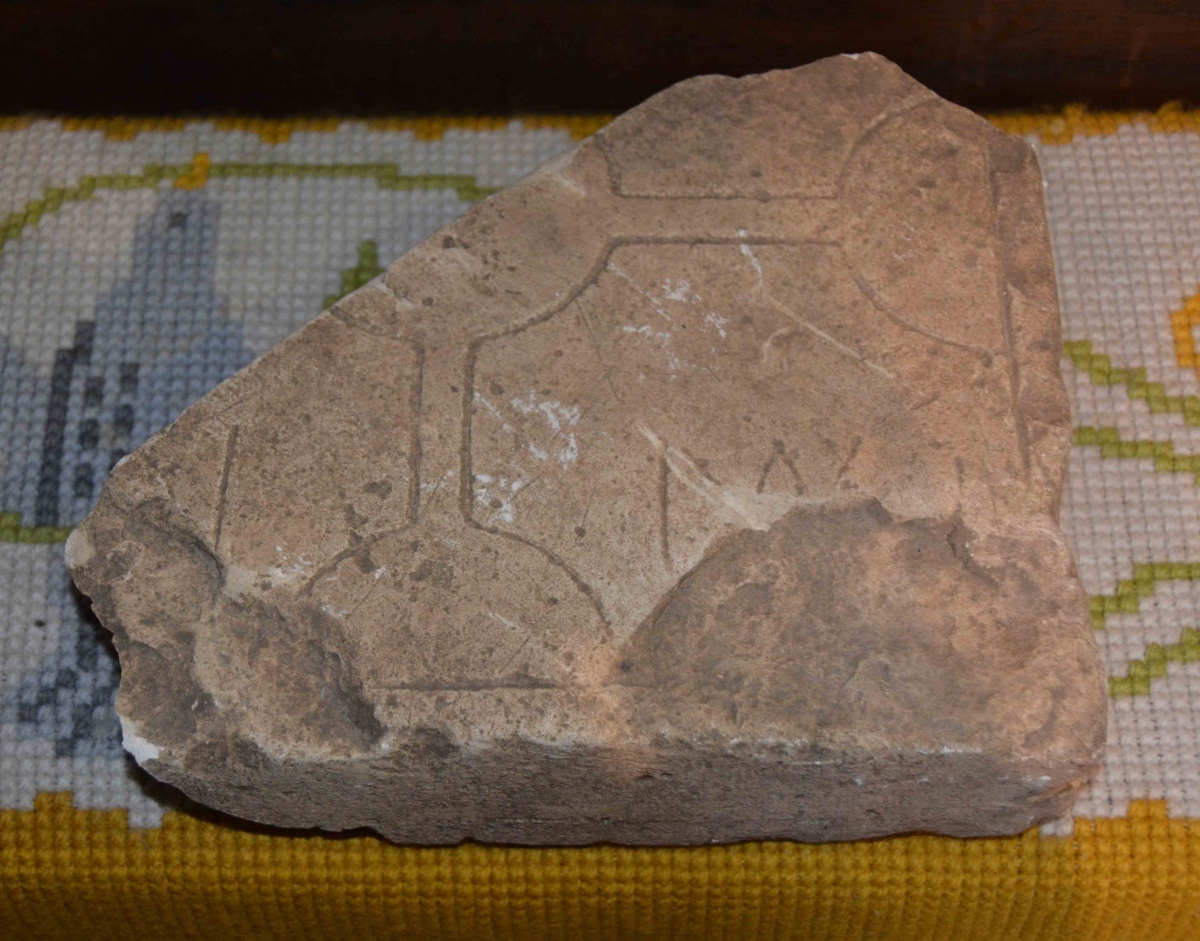
St Mary Magdalene (Hart) submitted by Anne T on 12th Feb 2020. This fragment of namestone/pillow stone is not recorded by either the Corpus of Anglo Saxon Stone Sculpture or Guy Poinds in his Gazetteer of Anglo Saxon and Viking Sites: Northumberland and County Durham. Fragments of what look like runic writing can be seen in the bottom left hand quadrant, and it is a much better example than the one in the Museum of Hartlepool. I have emailed the vicar asking if she has any information about where and when it was found.
(View photo, vote or add a comment)
Log Text: St Mary Magdalene, Hart: From the exterior of the building, I did not expect to 'walk back in time' into this splendid parish church. Such a sense of history, and what fragments of sculptured stones - a real treat. The church was only open for an hour on Wednesdays, between 3pm and 4pm at this time of year, essentially for quiet prayer, but the time flew, and we kept the church warden longer than intended. I would have loved to have spent another hour here, just enjoying the atmosphere.
St Hilda's Wayside Cross (Hartlepool)
Trip No.156 Entry No.2 Date Added: 11th Feb 2020
Site Type: Ancient Cross
Country: England (County Durham)
Visited: Yes on 5th Feb 2020. My rating: Condition 3 Ambience 4 Access 5

St Hilda's Wayside Cross (Hartlepool) submitted by Anne T on 11th Feb 2020. Looking down into the socket hole of the cross base, which is about 20cms square, and 5-6cms deep. The remains of old lead can be seen around the edges of the socket hole, indicating it once held a cross shaft or other fragment.
(View photo, vote or add a comment)
Log Text: Wayside Cross base outside St Hilda's Church: I spotted this more by accident than design, and photographed it, before we rushed off to the old Gray Art Gallery and Museum site to try and track down its old site. We couldn't find it where the grid reference placed it. A worker from the now office building, William Gray House, which now houses the Council and Tees Archaeology, told us the art gallery had closed in 1995 although people still came looking for it. He had no knowledge of a cross base in the grounds.
It wasn't until I got home and was doing some research that I came across the HE entry, which we hadn't seen earlier, which told us the cross base had been moved to this location in 1997.
St Hilda's Church (Hartlepool)
Trip No.156 Entry No.1 Date Added: 11th Feb 2020
Site Type: Early Christian Sculptured Stone
Country: England (County Durham)
Visited: Yes on 5th Feb 2020. My rating: Condition 4 Ambience 4 Access 4
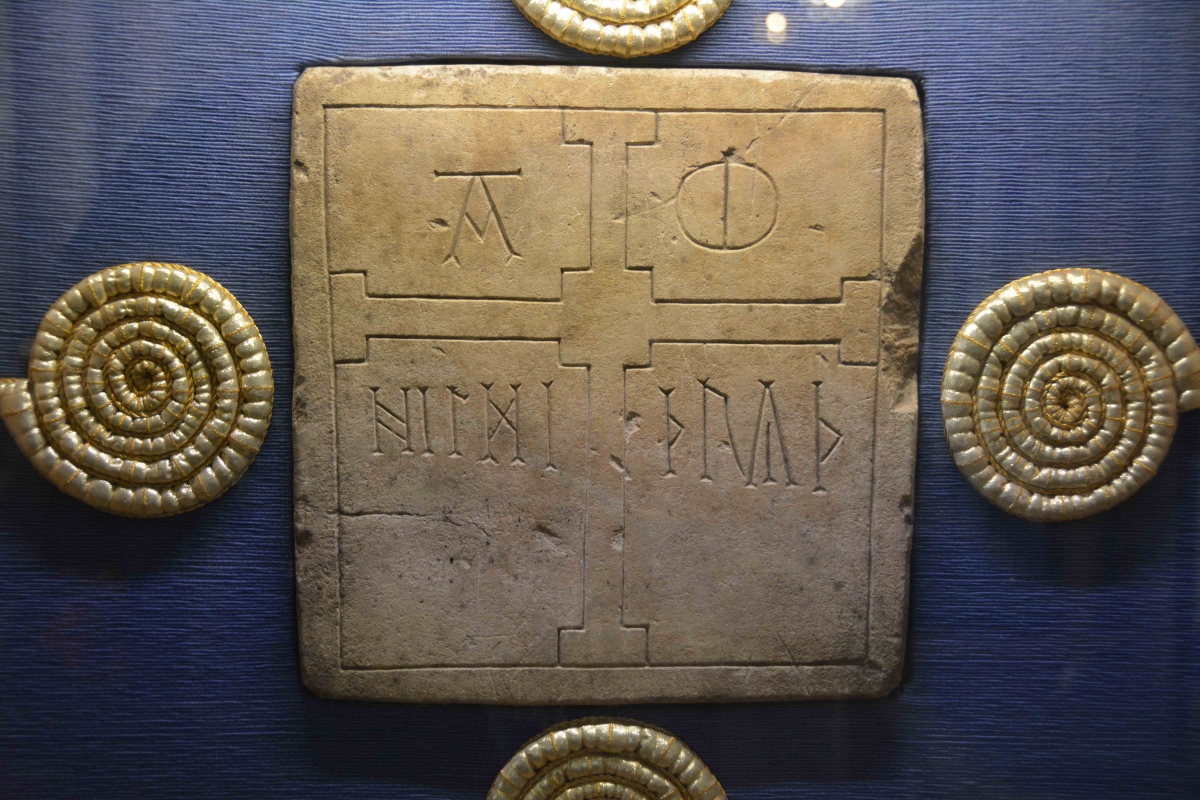
St Hilda's Church (Hartlepool) submitted by Anne T on 11th Feb 2020. The impressive Hildthryth namestone, on display on the eastern wall of the St Nicolas Chapel, on the southern side of the sanctuary. Also recorded as Hartlepool 01 on the Corpus of Anglo Saxon Stone Sculpture. The stone measures 27cms high, 29cms wide and 11cms deep. Poinds tells us: "The west face is decorated with a plain border which surrounds a large cross whose centre is square rather than circular and whose cross arms are square ended. The lettering on each side of the upper vertical arm o...
(View photo, vote or add a comment)
Log Text: St Hilda's, the Headland, Hartlepool: What a magnificent building, with its collection of huge flying buttresses supporting the external walls of the tower. Inside, it is more like a mini-cathedral than a parish church.
We had the pleasure of being greeted by Mr. John Hogg, parishioner with responsibility for Visitor Ministry, and the most knowledgeable guide we could wish to meet.
We spent almost the full hour and a half looking round the church, the fragments in the Brus Chapel and the old south door, plus admiring the Hildthryth stone in the St Nicholas Chapel. I just wish the opening hours of the church had been longer, as I was really interested to see the display boards located around the south and north walls of the nave.
The altar rails are also interesting, as they are made of 1,000 year old oak (but do look Victorian!). A real gem, and well worth a visit.
Pocklington's Druid Stone
Trip No.155 Entry No.3 Date Added: 15th Jan 2020
Site Type: Modern Stone Circle etc
Country: England (Cumbria)
Visited: Yes on 12th Jan 2020. My rating: Condition 4 Ambience 4 Access 4
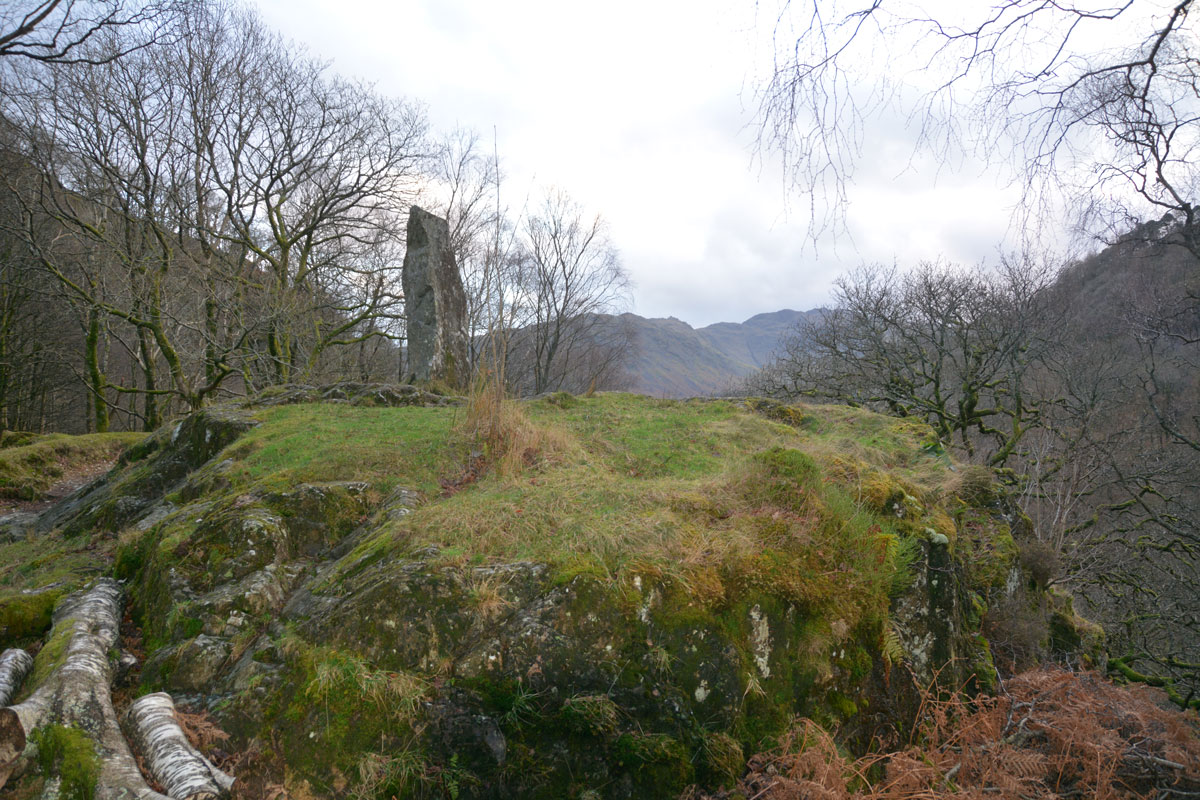
Pocklington's Druid Stone submitted by Anne T on 15th Jan 2020. Pocklington's Druid Stone, a relatively modern megalith, having been erected here in around 1778, stands on top of a rocky outcrop just to the south of the Bowder Stone. This view looks south, with the B5289 and the River Derwent below.
(View photo, vote or add a comment)
Log Text: Pockington's Druid Stone at the Bowder Stone: A short distance from the Bowder Stone, almost hidden from sight by a small cottage, this 'modern' monolith stands on top of a rocky outcrop high above the road below. At first, I thought it might be a memorial, as there appeared to be writing on the stone. Getting closer, the 'writing' was just striations on the stone.
Bowder Stone
Trip No.155 Entry No.2 Date Added: 15th Jan 2020
Site Type: Natural Stone / Erratic / Other Natural Feature
Country: England (Cumbria)
Visited: Yes on 12th Jan 2020. My rating: Condition 3 Ambience 4 Access 4
Bowder Stone submitted by maigo on 25th Jun 2013. May2009
(View photo, vote or add a comment)
Log Text: The Bowder Stone, Borrowdale: We parked in the car park (there is a small charge) and walked the quarter of a mile to this enormous boulder. The last time we came here, some time ago, we walked through the quarry and I remember photographing all the old tree roots emerging from the rock and forming strange and complex patterns. Not so now, a recent path runs uphill, following the western side of the boundary for the quarry.
As usual, there was a party of young people, complete with mattresses, bouldering underneath the overhang. It was amusing to stand and watch them, although some of the tumbles looked a bit painful.
Andrew headed up the ladder to the platform at the top, whilst I wandered round the other side of the stone, a megalith catching my eye.
Borrowdale Stone Monument
Trip No.155 Entry No.1 Date Added: 15th Jan 2020
Site Type: Standing Stones
Country: England (Cumbria)
Visited: Yes on 12th Jan 2020. My rating: Condition 3 Ambience 4 Access 3
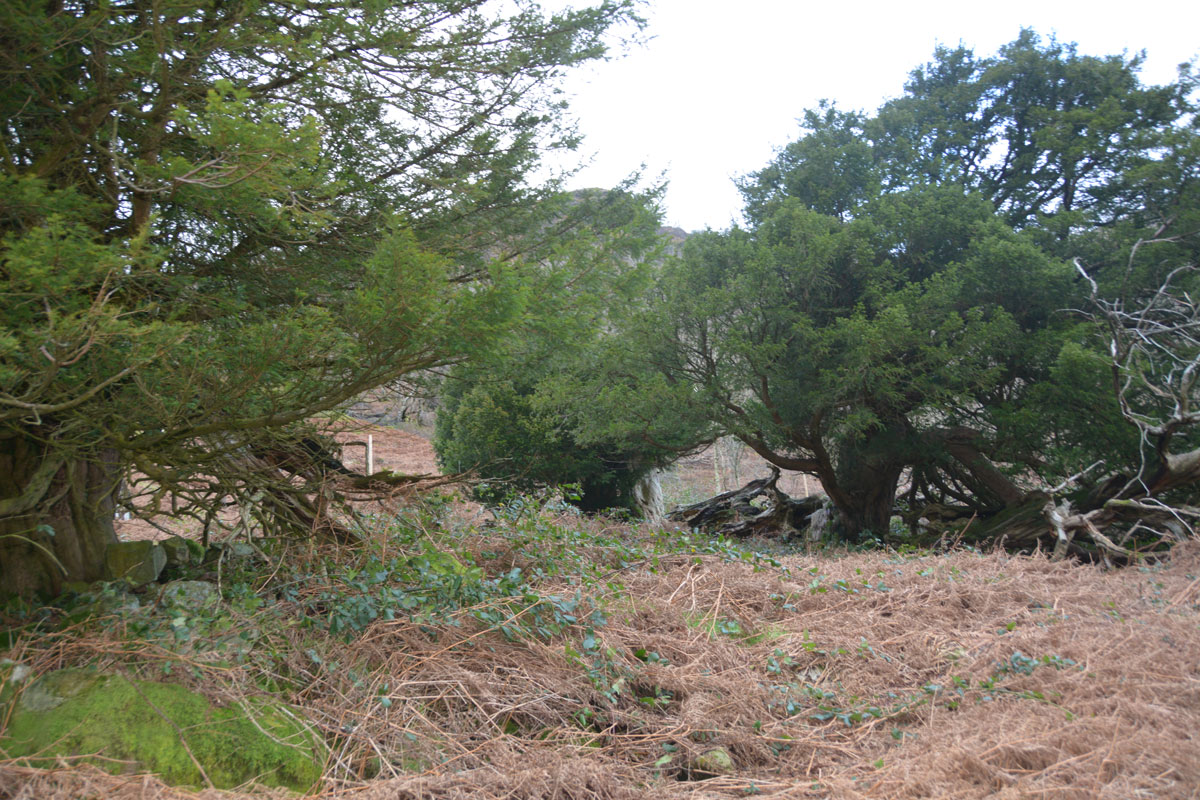
Borrowdale Stone Monument submitted by Anne T on 15th Jan 2020. Some of the smaller boulders have been cleared and piled up around the base of these ancient yew trees. Certainly very impressive trees and very old indeed. Well worth a visit. Photograph by Andrew T.
(View photo, vote or add a comment)
Log Text: Borrowdale Yews and the possible stone monument: Our first trip out for several months, and a way of escaping the windy and wet weather here in Northumberland. However, we arrived in a Cumbria that had experienced very heavy rain over recent days, and the small stream were swollen and many of the roads were flooded, although still passable.
We parked in the small car park near Seathwaite Farm, which is also a camping site and walked through the fields to the two bridges crossing the river(s). There are also a number of other streams to be crossed between here and the yew tree enclosure; at times of dry weather these would be easy to cross. On this occasion, a bit of balancing on convenient ‘stepping stones’ was in order!
The slope up to the yew tree enclosure was very slippery, so I sent Andrew up with the camera to explore. He came back saying the stones are definitely aligned in what seems to be a row, although I remained very sceptical, as there are a huge number of other boulders (large and small) on the hillside. Looking at the site from the south of river, by the car park, there seems to be the remains of the lower half of a double stone circle to the south west of the yew tree enclosure, although this could also just be coincidence.
This area was very heavily mined for graphite from 1555 onwards, and the remains of some of the industrial buildings can still be seen.
Sorry, but I remain unconvinced this is a stone row or alignment – there were so many other short rows of seemingly aligned stones on the hillside, this seemed like coincidence to me.
St Nicholas's Cathedral (Newcastle)
Trip No.154 Entry No.2 Date Added: 21st Oct 2019
Site Type: Ancient Cross
Country: England (Tyne and Wear)
Visited: Yes on 16th Oct 2019. My rating: Condition 2 Ambience 2 Access 4
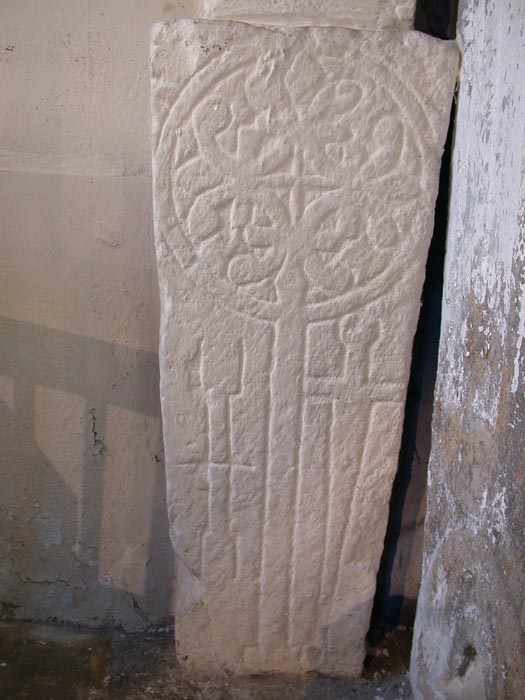
St Nicholas's Cathedral (Newcastle) submitted by nicoladidsbury on 13th Aug 2005. Elaborate Cross Slab, featuring two vertical sword shafts, similar to much smaller cross slabs found built into the fabric of the Norman wall in the ancient church at Old Ireby
(View photo, vote or add a comment)
Log Text: St Nicholas's Cathedral, Newcastle: I'd arranged with one of the vergers, James, to meet him at noon on 16th October to be allowed down into the vault below the south transept to see the cross slabs now stored down there.
The space is now used as a chair store, with a scissor lift at its southern end, and a larger trap door which comes up underneath the piano in the south transept.
Access was through a trap door, with a vertical ladder which started a couple of feet below the floor of the transept, so I bottled out of climbing down, and sent Andrew down with the camera.
He reported that it was really interesting seeing this space, with its barrel vaulted ceiling, but the slabs had all been stored against a wall underneath a pile of tables and other general items. What he could see looked very worn, which is presumably why they were stored down here in the first place. The stones must have deteriorated alarmingly in the 100 years or so since they were drawn by C.C. Hodges.
Disappointing. They were tuning the organ whilst we were there, which was interesting. The open trap door caused interest from other visitors to the Cathedral who wanted to look down. I volunteered to stop anyone falling down the trapdoor, so got to talk to quite a few people who were interesting in seeing this space.
St Nicholas's Cathedral (Newcastle)
Date Added: 21st Oct 2019
Site Type: Ancient Cross
Country: England (Tyne and Wear)
Visited: Yes on 6th Oct 2019. My rating: Condition 3 Ambience 4 Access 4

St Nicholas's Cathedral (Newcastle) submitted by nicoladidsbury on 13th Aug 2005. Elaborate Cross Slab, featuring two vertical sword shafts, similar to much smaller cross slabs found built into the fabric of the Norman wall in the ancient church at Old Ireby
(View photo, vote or add a comment)
Log Text: St Nicholas's Cathedral, Newcastle: We went to photograph the four cross slabs recorded by Ryder in St Margaret's Chapel, plus two others - one in the western of the three tomb recesses in the south wall of the south aisle; the other in the south wall of the south transept, at its eastern end.
I've since arranged to return on 16th October to photograph the slabs now stored in the vault under the south transept, although access is through a trapdoor and down a ladder!
Girth Cross (Canongate)
Trip No.153 Entry No.4 Date Added: 9th Oct 2019
Site Type: Ancient Cross
Country: Scotland (Midlothian)
Visited: Yes on 1st Oct 2019. My rating: Condition -1 Ambience 3 Access 5
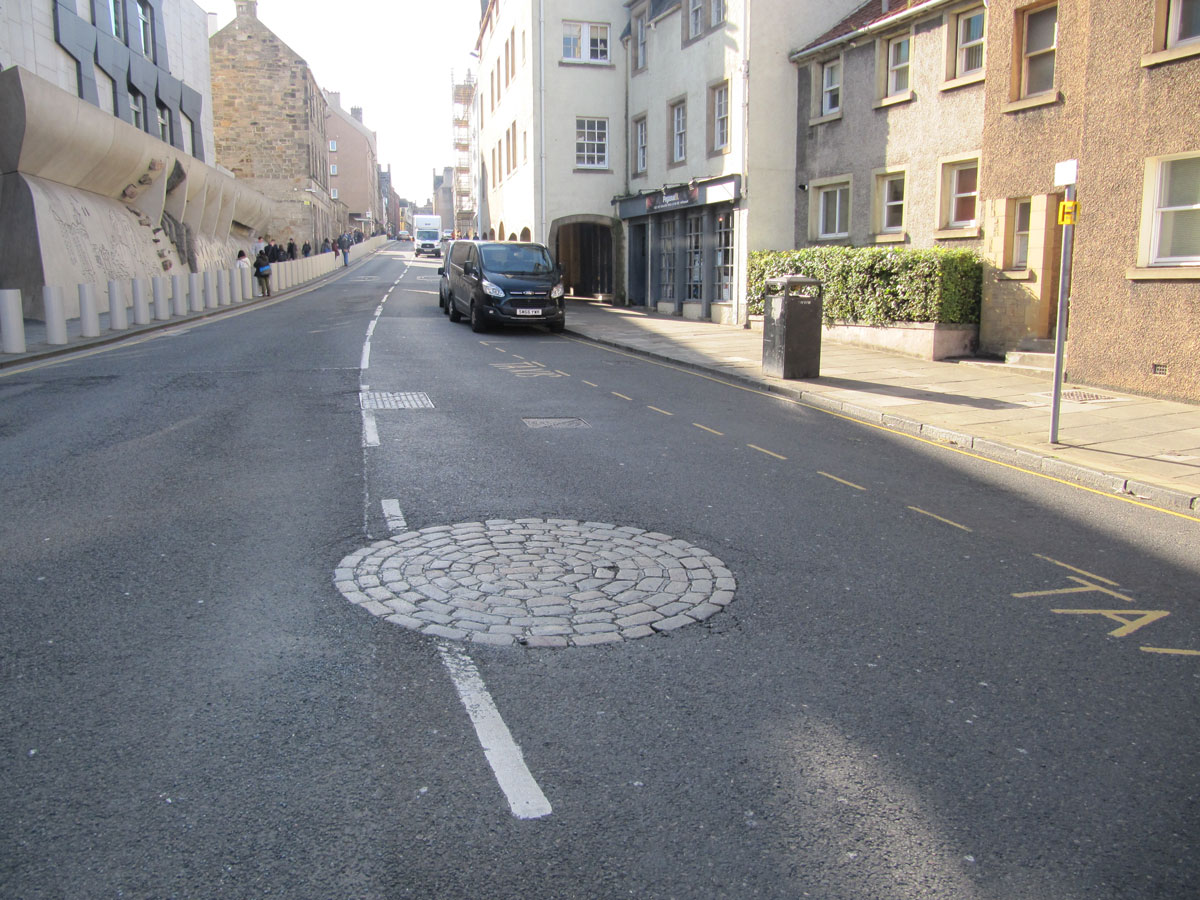
Girth Cross (Canongate) submitted by Anne T on 9th Oct 2019. Standing on the pedestrian island at the western side of the roundabout, I had to wait for ages to get a view without traffic whizzing by on either side. The outer wall Scottish Parliament building is on the left hand side of the photograph. This view looks west up Canongate. If I hadn't have known, from our Treasure Trail clues, that this was the site of the cross, I would have passed it by, but it marks the western limit of the Girth of Holyrood, the largest sanctuary in Scotland, and the las...
(View photo, vote or add a comment)
Log Text: Site of the Girth Cross, Canongate: Again, we picked this location up from the Treasure Trail, after Clue 15, there is a ‘Did you know?’ box which reads: “Where Canongate meets Abbeyhill look out for the circle of cobbles. This is the site of the ‘Old Girth Cross’ where proclamations and executions took place. In 1600 Lady Warriston was beheaded by guillotine for conspiring to murder her abusive husband”.
This site is at a very busy road junction, west of Holyrood Palace, and at the eastern end of Canongate, where Canongate meets Abbeyhill, Abbey Strand and Horse Wynd.
Not much to see really, apart from a circle of grey pavers
Canongate Mercat Cross
Trip No.153 Entry No.2 Date Added: 9th Oct 2019
Site Type: Ancient Cross
Country: Scotland (Midlothian)
Visited: Yes on 1st Oct 2019. My rating: Condition 3 Ambience 4 Access 4
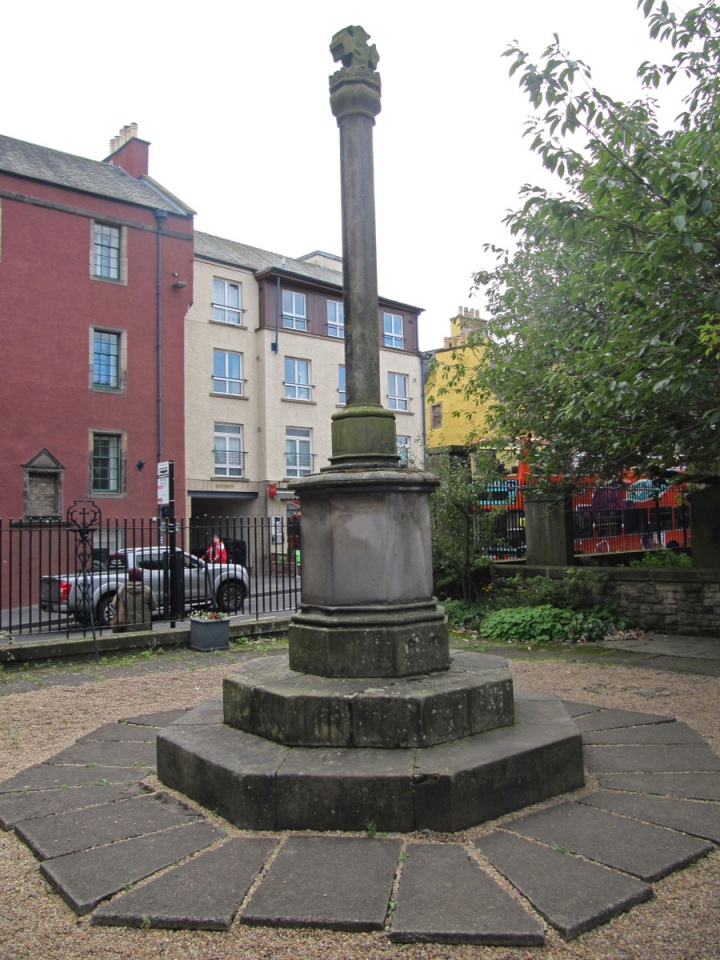
Canongate Mercat Cross submitted by Anne T on 9th Oct 2019. Standing in the NE corner of the courtyard, looking SW to Canongate. The cross looks modern, but then Canmore (and British Listed Buildings) tell us that the octagonal cross shaft is original; the rest are 'modern' replacements.
(View photo, vote or add a comment)
Log Text: Canongate Mercat Cross: Again, we found this cross by chance by following the clues on the "Old Edinburgh Town" Treasure Trail, whilst looking for the answers to two clues within the churchyard. I am sure I annoyed my friend by stopping to photograph all the sites of ancient crosses and wells that we came across, as our 2 hour 'trail' took 4 hours (although this included a coffee and cake stop, too).
Never really having explored Edinburgh Old Town, I was really surprised to find out how much, and how historic, Canongate and surrounding area is.
Thimbleby Nine Stones
Trip No.2 Entry No.1 Date Added: 9th Oct 2019
Site Type: Standing Stones
Country: England (Yorkshire (North))
Visited: Yes on 9th Jun 2016. My rating: Condition 3 Ambience 4 Access 3
Thimbleby Nine Stones submitted by SolarMegalith on 15th Mar 2013. Northern pair of standing stones - view from the south (photo taken on March 2013).
(View photo, vote or add a comment)
Log Text: Nine Stones Stone Row, near Osmotherley, North Yorkshire: Having added a few of the Stone Rows of Great Britain sites on the Portal, and needing to go down to Thirsk it was too much of a temptation to resist visiting one or two of the North Yorkshire sites. With only a 3 hour window before having to travel onto Doncaster, the only one we could reach and explore in time was Nine Stones, just outside Osmotherley.
We’ve been to this area before to look at Anglo Saxon crosses in churches and ended up getting hopelessly lost, but this time we had the OS map and our GPS. With the sun shining down from an almost cloudless sky, we reached the car park at Square Corner easily enough. It never ceases to amaze me that there are so many more people in this part of the world than in Northumberland. There were people picnicking on the side of the road near Solomon's Temple enjoying a wonderful view over Oak Dale valley and the woods of Crabtree Bank and Thimbleby Bank Plantations.
As we pulled up, a number of dog walkers drew up, chattering noisily, and I hoped they weren’t going to follow us and destroy the peace and quiet of the afternoon (I’m definitely getting to be a grumpy old woman!). Fortunately, they followed the Cleveland Way up the hill to the south.
From the car park, we walked the couple of hundred metres to the gate where the footpath west over Thimbleby Moor and the Cleveland Way southwards meet. The GPS told us there was almost 700 metres to walk to Nine Stones, so we set off over the stile over the wall by a second gate to the west. The first couple of hundred yards were easy walking along a stoned footpath leading off to some modern shooting butts to the west. After 200 metres we needed to veer off southwards to follow the dry stone wall westwards. This was all through knee deep heather with the occasional field drain and boggy patch thrown in. After another 200 yards we realised we’d reached a much quarried area; there were deep holes full of water which we could only see when we were almost upon them. I managed to disappear up to my ankles in one, although there were other that looked far deeper.
Whilst the area has many blocks of stone poking up through the heather, towards the top of the slope there suddenly appeared on the horizon two standing stones, looming large, beckoning the walker. Here was (were?) Nine Stones, at last.
This stone row was well worth the trudge through the undergrowth. At the northern tip of the row there are five stones, two tall, two stumpy and one almost buried in the heather. We wondered which were actually part of the stone row. The north-western most stone looked as if there had been an attempt to quarry the top of it in the distant past (comparing the holes to some at Edges Green, near Cawfields) that we’ve seen recently.
Two more tall stones sit close to the stone wall, and a few more stones appear further south in the forested area. The Stone Rows of Great Britain site tell us that this stone row is 60 metres long, but husband, tramping through the forest, thought it might be possible that the row was nearer to 100 metres (but then which are natural stones and which are recumbent standing stones?).
There are so many other features in this area to explore: Miley Pike Tumulus, Robinson’s Cross (remains of), a Holy Well, Faber’s Stone – well worth a repeat visit.
West Wykes Farm Tau and Latin Crosses
Trip No.132 Entry No.16 Date Added: 9th Oct 2019
Site Type: Ancient Cross
Country: England (Devon)
Visited: Yes on 13th May 2019. My rating: Condition 3 Ambience 5 Access 4

West Wykes Farm Tau and Latin Crosses submitted by Anne T on 9th Jun 2019. The Latin cross under the tree at West Wyke farm, having been rescued from 'duty as a gatepost' by E. Masson Phillips in 1958 and erected here. The cross has lost one of its arms, and on each face there is are incised Latin crosses. One, carved somewhat lopsidedly is 1 foot 7 inches high by 1 foot 2 inches. On the reverse face the cross measures 11 inches high by 11 inches across. Just to the right of the tree (just above centre right of the photo) can be see the octagonal arm of the Tau cross.
(View photo, vote or add a comment)
Log Text: West Wyke Tau and Latin Crosses: The lane to West Wyke farm and the houses here is marked private, so we parked at the viewpoint at SX 65298 93020 and walked the 600m or so up the lane - a very pleasant walk in the evening sunshine.
Despite taking the HE and Pastcape printouts with us, I didn't appreciate what I'd seen until sitting at the computer today (9th June 2019). Good job I photographed the pile of stones at the western side of the tree, as this was the Tau Cross! The smaller cross next to the entrance to the barns on the opposite side of the road is not recorded on HE or Pastscape, and I'd been really confused until re-reading the entries.
West Wyke Farm Cross
Trip No.132 Entry No.15 Date Added: 9th Oct 2019
Site Type: Ancient Cross
Country: England (Devon)
Visited: Yes on 13th May 2019. My rating: Condition 3 Ambience 3 Access 4

West Wyke Farm Cross submitted by Anne T on 9th Jun 2019. This cross sits just to the west of the entrance to farm buildings on the northern side of the track. It stands about 18 inches / 45 cms high.
(View photo, vote or add a comment)
Log Text: West Wyke Farm Cross: This cross is not recorded on Pastscape or Historic England, so we didn't expect to see it here. It looks relatively modern, like a small rounded-headed grave marker such as we saw in St Mary's in Belstone. It sits quietly by the entrance to the farm buildings, north of the track and West Wyke farmhouse.
Note: the track up to the farm and houses here is marked private road. We parked at the viewpoint at SX 65298 93020 and walked up the lane.
St John's Cross (Canongate)
Trip No.153 Entry No.1 Date Added: 9th Oct 2019
Site Type: Ancient Cross
Country: Scotland (Midlothian)
Visited: Yes on 1st Oct 2019. My rating: Condition 2 Ambience 3 Access 4

St John's Cross (Canongate) submitted by Anne T on 9th Oct 2019. The location of the old St John's Cross (now said to be outside Canongate Kirk). Whilst the location is said to be marked by a white St John's Cross, the paint had almost been worn away, and if I hadn't seen similar circles of pavers in other locations, might not have recognised the spot. Having spotted the circle, a closer look around revealed the plaque describing the cross on an adjacent wall in deep shadow on the south side of Canongate.
(View photo, vote or add a comment)
Log Text: St John's Cross, Edinburgh (site of): The site of this cross was one of the clues (no. 6) on the 'Treasure Trail' map for the Old Town Trail. The markings for this cross were very faint indeed. I only recognised the spot by the circle of bricks in the road, as I’d seen similar features before. There is a plaque on the wall nearby.
From the funny, small brass plates in the road and pavement just to the west, at the junction of High Street and Canongate (W-E) and Jeffrey Street-Saint Mary's Street to the east, the cross would have been located just outside the old city walls.
Whilst I've been to Edinburgh on a number of occasions, I have never walked down Canongate before, and it was a great spot for discovering 'old things and old sites'.
St Andrew's Church (Bywell)
Trip No.150 Entry No.2 Date Added: 27th Sep 2019
Site Type: Ancient Cross
Country: England (Northumberland)
Visited: Yes on 10th Sep 2019. My rating: Condition 3 Ambience 4 Access 4
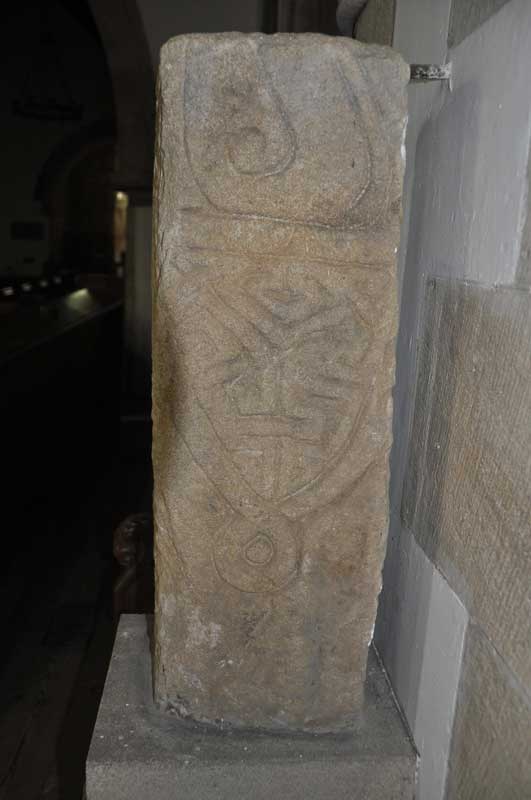
St Andrew's Church (Bywell) submitted by Anne T on 30th Sep 2014. Close up of the second decorated side of the larger fragment, which is the lower part of a cross shaft (Corpus of Anglo-Saxon Stone Sculpture reference: Bywell 01). This face shows the remains of a ring knot and shield shaped pendant.
(View photo, vote or add a comment)
Log Text: St Andrew's Church, Bywell: Living only a few miles from here and having visited, and taken friends there, many times over the years, it seemed remiss not to go down and photograph the wonderful collection of medieval cross slabs built into the fabric of this ancient church. Armed with Peter Ryder's "Medieval Cross Slab Grave Covers in Northumberland, 1: South West Northumberland" from Archaeologia Aeliana, Series 5, XXVIII, we were able to find all the slabs on his list - 27 in total. Brilliant! Really enjoyed this visit.
St Peter's (Bywell)
Trip No.151 Entry No.1 Date Added: 27th Sep 2019
Site Type: Early Christian Sculptured Stone
Country: England (Northumberland)
Visited: Yes on 14th Sep 2019. My rating: Condition 3 Ambience 4 Access 5
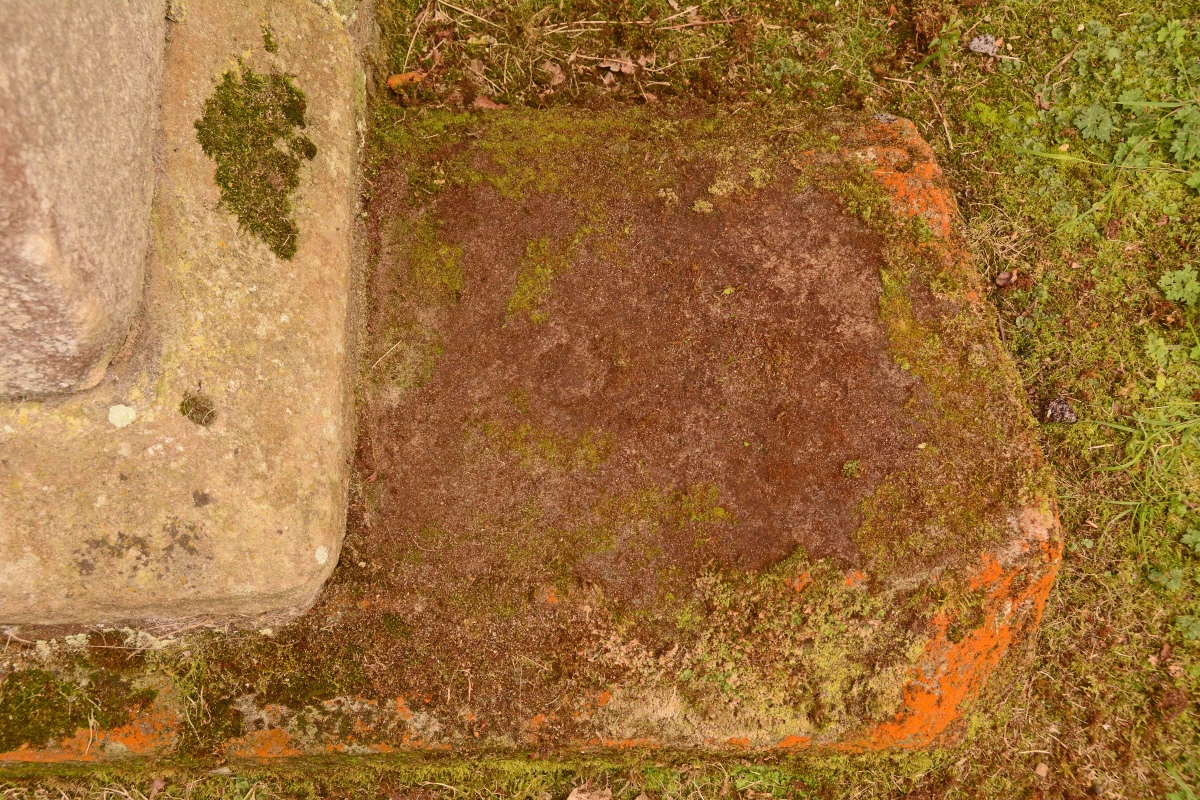
St Peter's (Bywell) submitted by Anne T on 27th Sep 2019. The visible portion of Ryder's Bywell (St Peter's) 13, with a "cross head set within a circle, with sunk lenticular segments between the arms, and a circle at the centre" on the visible section. The small circle can be seen just left of centre of the photograph; the rest of the design is hidden by moss.
(View photo, vote or add a comment)
Log Text: St Peter's, Bywell: Having photographed the cross slabs at St. Andrew's on 10th September 2019, we walked down to St Peter's to try and photograph the slabs Peter Ryder has recorded here. Unfortunately, the church was locked, so we photographed the few slabs on the outside of the building, returning on 14th September, after having ascertained from the vicar the church's opening hours.
This is a really lovely spot, right next to the River Tyne, with the Bywell Village/Market cross and St Andrew's Church, Bywell, with its significant collection of medieval cross slabs and its Anglo Saxon sculptured stones.
St Andrew's Church (Corbridge)
Date Added: 26th Sep 2019
Site Type: Ancient Cross
Country: England (Northumberland)
Visited: Yes on 14th Sep 2019. My rating: Condition 3 Ambience 4 Access 5
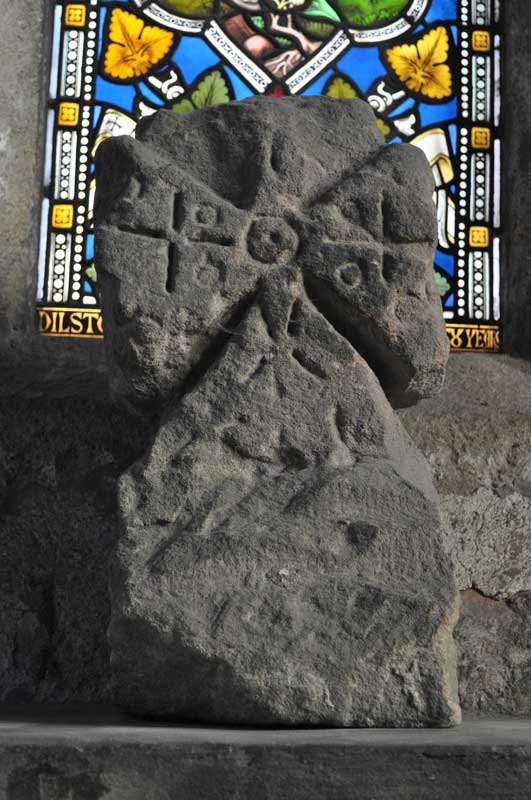
St Andrew's Church (Corbridge) submitted by Anne T on 7th Oct 2014. The eleventh century finial, though to be from the gable end of the original church. Currently located in the South Transept
(ASCorpus ref: Corbridge 05).
(View photo, vote or add a comment)
Log Text: St. Andrew's Church, Corbridge: We returned to this beautiful church, right in the heart of Corbridge, with Peter Ryder's list of medieval grave slabs. Not to be confused with St. Andrew's, Bywell, about 6 miles away.
Always a draw for visitors, this is a peaceful and thought provoking church. As we started on our list of slabs, working out way down the list from 1-21, the Canon came in with a couple of choristers and started practicing for a service, so parts of the church were 'out of bounds' to avoid disturbing them. We returned briefly on Sunday, 22nd September, mid-afternoon, to photograph the couple of slabs remaining. We were unable to find slab 21, but later realised we were looking in the wrong place, so will return to complete the list.
